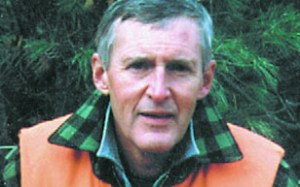When Robert Romano wrote his first Rangeley novel, “North of Easie, “ Wayne Hooper of the Portsmouth Herald wrote of it: “It is funny, sad, happy and all of the highs and lows that affect people, who all know each other in a small town in a remote area…I just hope that Romano has a sequel in mind.”
Indeed, he did.
Hot off the press, the sequel is called “West of Rangeley.” It is a lot like the first book in that it deals with small-town Maine, flawed people – many of whom are addicted to fly fishing – and enough tension to keep you interested. Romano’s main character is a broken down old guy named Sal D’Amico. He is an urban expatriot who moved to the Maine mountains to find his sanity. A fishing guide, he lives in a cabin on a small Rangley lake not far from Easie. Despite having the usual health afflictions that find their way to aging folks, even guides, Sal has a live-in girl friend who shares his fondness for mountain air, casting a fly to a rising trout, and moments of intimacy.
Although the book got me off to a slow start, I stayed with it because I knew from reading “North of Easie” that Romano, in time, would weave a good tale. I also knew that Romano has another skill that I find admirable. He is very adept at creating sense of place. His dialogue is authentic and his characters have life. His descriptions of sunsets and little critters can be a tad protracted, but, like his characters, his word pictures grow on you. Romano has a well-trained eye and his capacity to observe the details and bring them to the page, is topnotch.
Here’s a sample. “Eddie worked the water, his fly line shooting back over his shoulder, swinging effortlessly outward over a series of sun-streaked rapids. The streamer tied to the end of his leader quickly sank under the surface, tumbling down with the current that emptied into a deep pool. One of my own creations, the bucktail consisted of three layers of deer hair – olive, purple and black – each secured one upon the other, on a hook shank wrapped with a bright green silk. I watched as the Big Fish worked the sparsely tied streamer fly down and across the back of the pool, stripping line in a manner so as to imitate the erratic motion of an injured smelt.”
The tension in Romano’s tale springs from a classic antagonist, one that you might expect from a story that celebrates clean water and wild trout – Big Development. When Sal discovers that his beloved Otter Pond is about to be bull-dozed for a condominium, his world falls apart. How he, his buddies, and the townspeople, deal with the impending blow to their way of life makes for a compelling plot.
Of course, a good novel always gives you characters that are larger than life. My favorite in this book is Eddie Goodfellow, a big former Marine who befriends Sal. “The large man’s voice was as deep as he was wide. Standing over six feet, with broad shoulders, hair erupting from under his desert tan T-shirt, spreading down his bulging biceps and curling up around his thick neck, the bear of a man could easily have been mistaken for one of those uninvited guests that occasionally lumber out of the forest to feed on my berries in early summer. His upper body evidenced a time when he had engaged in extensive physical activity, while the enormous belly hanging over his belt bore witness to a change in lifestyle. He had the Chinese symbol for the Tao tattooed across his right biceps; on his left a fish appeared to dance upon its tail.”
Goodfellow, an enterprising fellow who knows that there is always more than one way to skin an unscrupulous Big Developer hatches a scheme to foil the pond wreckers. At this point, things get really interesting. But you must buy the book to find out how it all pans out.
“West of Rangeley,” a novel by Robert J. Romano, published by Birch Brook Press, $22.00. www.birchbrookpress.info.
V. Paul Reynolds is editor of the Northwoods Sporting Journal. He is also a Maine Guide, co-host of a weekly radio program “Maine Outdoors” heard Sundays at 7 p.m. on The Voice of Maine News-Talk Network (WVOM-FM 103.9, WQVM-FM 101.3) and former information officer for the Maine Dept. of Fish and Wildlife. His e-mail address is [email protected] and his new book is “A Maine Deer Hunter’s Logbook.”

Comments are no longer available on this story